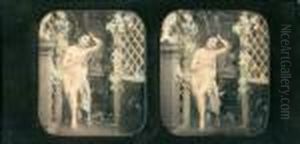Bruno Braquehais Paintings
Bruno Braquehais was a French photographer born in Dieppe, France, in 1823. Although not as widely recognized as some of his contemporaries, Braquehais played a significant role in the development of early photography and is best known for his work during the Paris Commune of 1871. His career offers insight into the evolution of photographic practices in the 19th century, as well as the potent political and social currents of his time.
Before embarking on his career in photography, Braquehais worked in the studio of his stepfather, Alexis Gouin, a well-regarded lithographer. This early exposure to the world of print and image production undoubtedly influenced Braquehais's later photographic work. By the 1850s, he had established himself as a photographer, specializing initially in stereoscopic images, which were a popular form of entertainment and education, offering three-dimensional views of landscapes, architecture, and historical sites.
The tumultuous events of the Paris Commune in 1871 provided a pivotal moment for Braquehais. He documented the uprising, the barricades, and the aftermath of the Commune's suppression by the French government. His photographs from this period are some of the earliest examples of photojournalism, capturing the raw and often brutal realities of civil conflict. These images not only serve as historical documents but also as poignant reminders of the power of photography to bear witness to societal upheaval.
After the fall of the Commune, Braquehais continued his work, but like many who were associated with the Commune, he faced suspicion and scrutiny. The political climate of the time, coupled with the economic difficulties of running a photographic studio, impacted his career adversely. Despite these challenges, he remained dedicated to his craft until his death in 1875.
Bruno Braquehais's contributions to photography, particularly his documentation of the Paris Commune, underscore the medium's capacity to capture and communicate the complexities of human experience. His work not only provides a visual record of a critical moment in French history but also exemplifies the emerging role of the photographer as observer and chronicler of contemporary events. Braquehais's legacy, though perhaps overshadowed by other figures in the history of photography, remains significant for his pioneering efforts in photojournalism and his dedication to the art and science of photography.
